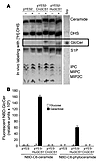Citations to this article
Citation Information: J Clin Invest. 2006;116(6):1651-1659. https://doi.org/10.1172/JCI27890.
Abstract
The pathogenic fungus Cryptococcus neoformans infects humans upon inhalation and causes the most common fungal meningoencephalitis in immunocompromised subjects worldwide. In the host, C. neoformans is found both intracellularly and extracellularly, but how these two components contribute to the development of the disease is largely unknown. Here we show that the glycosphingolipid glucosylceramide (GlcCer), which is present in C. neoformans, was essential for fungal growth in host extracellular environments, such as in alveolar spaces and in the bloodstream, which are characterized by a neutral/alkaline pH, but not in the host intracellular environment, such as in the phagolysosome of macrophages, which is characteristically acidic. Indeed, a C. neoformans mutant strain lacking GlcCer did not grow in vitro at a neutral/alkaline pH, yet it had no growth defect at an acidic pH. The mechanism by which GlcCer regulates alkali tolerance was by allowing the transition of C. neoformans through the cell cycle. This study establishes C. neoformans GlcCer as a key virulence factor of cryptococcal pathogenicity, with important implications for future development of new antifungal strategies.
Authors
Philipp C. Rittershaus, Talar B. Kechichian, Jeremy C. Allegood, Alfred H. Merrill, Mirko Hennig, Chiara Luberto, Maurizio Del Poeta
Total citations by year

Citations to this article in year 2021 (15)
| Title and authors | Publication | Year |
|---|---|---|
|
Functions of Sphingolipids in Pathogenesis During Host–Pathogen Interactions
J Wang, YL Chen, YK Li, DK Chen, JF He, N Yao |
Frontiers in microbiology | 2021 |
|
Treatment strategies for cryptococcal infection: challenges, advances and future outlook
KR Iyer, NM Revie, C Fu, N Robbins, LE Cowen |
Nature Reviews Microbiology | 2021 |
|
Vaccine-Induced Immunological Memory in Invasive Fungal Infections – A Dream so Close yet so Far
PS Biswas |
Frontiers in immunology | 2021 |
|
The granuloma in cryptococcal disease
LC Ristow, JM Davis, A Chowdhary |
PLoS pathogens | 2021 |
|
P-Type ATPase Apt1 of the Fungal Pathogen Cryptococcus neoformans Is a Lipid Flippase of Broad Substrate Specificity
LD Stanchev, J Rizzo, R Peschel, LA Pazurek, L Bredegaard, S Veit, S Laerbusch, ML Rodrigues, RL López-Marqués, TG Pomorski |
Journal of Fungi | 2021 |
|
Omics Approaches for Understanding Biogenesis, Composition and Functions of Fungal Extracellular Vesicles
D Zamith-Miranda, RP da Silva, SP Couvillion, EL Bredeweg, MC Burnet, C Coelho, E Camacho, L Nimrichter, R Puccia, IC Almeida, A Casadevall, ML Rodrigues, LR Alves, JD Nosanchuk, ES Nakayasu |
Frontiers in Genetics | 2021 |
|
Miltefosine Against Scedosporium and Lomentospora Species: Antifungal Activity and Its Effects on Fungal Cells
R Rollin-Pinheiro, Y de Castro Almeida, VP Rochetti, MI da Silva Xisto, LP Borba-Santos, S Rozental, E Barreto-Bergter |
Frontiers in Cellular and Infection Microbiology | 2021 |
|
Sphingolipid Inhibitors as an Alternative to Treat Candidiasis Caused by Fluconazole-Resistant Strains
R Rollin-Pinheiro, B Bayona-Pacheco, LT Domingos, JA da Rocha Curvelo, GM de Castro, E Barreto-Bergter, A Ferreira-Pereira |
Pathogens | 2021 |
|
Comparative Molecular and Immunoregulatory Analysis of Extracellular Vesicles from Candida albicans and Candida auris
D Zamith-Miranda, HM Heyman, SP Couvillion, RJ Cordero, ML Rodrigues, L Nimrichter, A Casadevall, RF Amatuzzi, LR Alves, ES Nakayasu, JD Nosanchuk, F Schmidt |
mSystems | 2021 |
|
Mass Spectrometry-Based Lipidomics: Methods and Protocols
FF Hsu |
2021 | |
|
Lipid Secretion by Parasitic Cells of Coccidioides Contributes to Disseminated Disease
CA Peláez-Jaramillo, MD Jiménez-Alzate, P Araque-Marin, CY Hung, N Castro-Lopez, GT Cole |
Frontiers in Cellular and Infection Microbiology | 2021 |
|
Differences in the Fatty Acid Profile, Morphology, and Tetraacetylphytosphingosine-Forming Capability Between Wild-Type and Mutant Wickerhamomyces ciferrii
JY Choi, HJ Hwang, WY Cho, J Choi, PC Lee |
Frontiers in Bioengineering and Biotechnology | 2021 |
|
Glycosphingolipids in Filamentous Fungi: Biological Roles and Potential Applications in Cosmetics and Health Foods
C Jiang, J Ge, B He, B Zeng |
Frontiers in microbiology | 2021 |
|
A Histoplasma capsulatum Lipid Metabolic Map Identifies Antifungal Targets
D Zamith-Miranda, HM Heyman, MC Burnet, SP Couvillion, X Zheng, N Munoz, WC Nelson, JE Kyle, EM Zink, KK Weitz, KJ Bloodsworth, G Clair, JD Zucker, JR Teuton, SH Payne, YM Kim, MR Gil, ES Baker, EL Bredeweg, JD Nosanchuk, ES Nakayasu, JW Kronstad |
mBio | 2021 |
|
Advances in Antifungal Drug Development: An Up-To-Date Mini Review
Bouz G, Doležal M |
Pharmaceuticals | 2021 |



Copyright © 2025 American Society for Clinical Investigation
ISSN: 0021-9738 (print), 1558-8238 (online)

